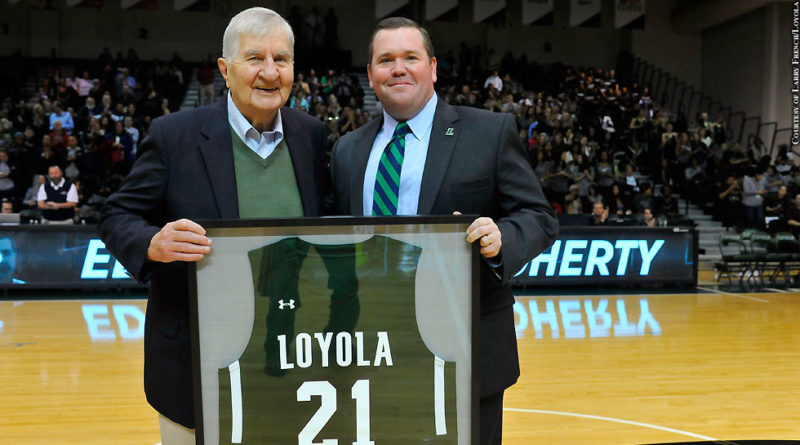Ed “Nap” Doherty is a basketball junkie. He’s too modest to admit that he even belongs to what he would consider a distinguished group, but there really is no other way to describe the affable Irishman who has been part of the local hoop scene for more than six decades.
It’s a long, probably often-told but rarely remembered story about how Doherty worked his way from the outdoor courts of Brooklyn, N.Y., to high school gyms in Kentucky, and then to a Hall of Fame playing and coaching career at what was then Loyola College, now Loyola University.
But for the throng of more than 50 former teammates and players who gathered to honor him at Reitz Arena Dec. 7, the memories were more about how Doherty left Loyola than how he got there. When he was let go in 1974, after a 13-year coaching career that produced a 164-153 record, the move alienated many in the tight-knit Loyola community. That it came only three years after a 19-7 record, one of the best in school history, which produced the first NCAA invitation to what was then called the Division II tournament, only added to anguish.
When word got out that Doherty would not return as coach following the 1973-74 season, it stirred unrest on the campus, especially the players. That team finished with seven straight losses and a 12-14 record, which may or may not have sealed the deal for Doherty, but it wasn’t because of any disconnect with his players.
Their support was evident when they chipped in to pay for a billboard ad along Cold Spring Lane, about a half-mile from the campus, protesting the decision. But it was to no avail, and Doherty’s long run had what many of his former teammates and players believed was a premature ending.
After a brilliant playing career, which he finished as Loyola’s third highest all-time scorer with 1,109 points, Doherty served a couple of years in the Army, and another year in banking in Brooklyn before being hand-picked by Emil G. “Lefty” Reitz to return to Loyola as his assistant.
Reitz was already a legend at Loyola, having, at various times, coached baseball, soccer and track in addition to basketball, while also serving as athletic director at the time. From the moment Doherty arrived back on the Evergreen campus, it was obvious he was being groomed to be Reitz’s successor.
Prior to Doherty’s arrival, and in the immediate years following, the Greyhounds relied almost exclusively on local players. As the competition for talent increased, Doherty became Loyola’s point man, venturing into Philadelphia and New York and becoming a familiar face on what was still a limited recruiting trail.
As a player, Doherty might best be described as feisty, and as a coach, his teams displayed that same trademark. They were aggressive but disciplined, a direct reflection of their coach, with whom the players quickly established bonds that would prove to be lasting.
During his tenure as a coach, Loyola often played in the shadow of Mount St. Mary’s, in the now defunct Mason-Dixon Conference, where the two schools nourished a rivalry that still stands as the longest in Maryland. Long before Maryland became a player in the Atlantic Coast Conference, games between Mount St. Mary’s and Loyola were the hottest story, and ticket, in town. The duels between Reitz and Doherty teams against those coached by Jim Phelan at Mount St. Mary’s produced classic games, great rivalries and treasured friendships.
To his everlasting credit, whatever bitterness Doherty might have felt remained hidden behind his ever-present smile. It wasn’t as easy for those who knew him as a friend, teammate or former player. But if the years take a toll, they also heal. Players and coaches come and go. So do regimes. The Loyola University of today is not the Loyola College of yesterday. Times change, people move on — and, thankfully, every once in a while, they look back.
Perhaps athletic director Jim Paquette said it best during the ceremonies Dec. 7.
“It’s important to remember where you’ve been as you look ahead,” Paquette said moments before presenting Doherty with a framed jersey bearing the No. 21 he wore as a player.
Some of us might think it’s overdue, but everybody can agree that the team in place at Loyola did its homework, did it right and did it first class. The same way Doherty did it as a player, coach and, more importantly, as a person.
Jim Henneman can be reached at JimH@pressboxonline.com
Issue 204: December 2014

